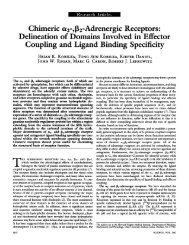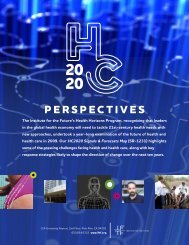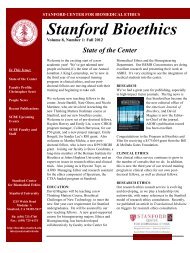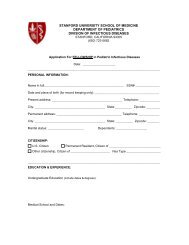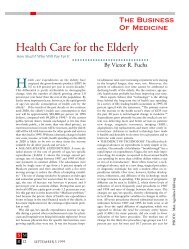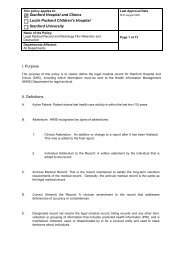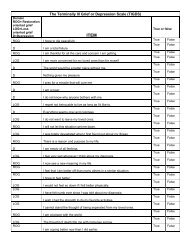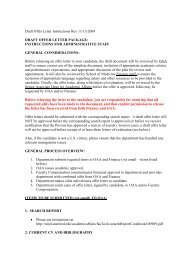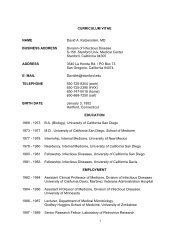HEAD & NECK SURGERY - Stanford University School of Medicine
HEAD & NECK SURGERY - Stanford University School of Medicine
HEAD & NECK SURGERY - Stanford University School of Medicine
You also want an ePaper? Increase the reach of your titles
YUMPU automatically turns print PDFs into web optimized ePapers that Google loves.
EVIDENCE-BASED MEDICINE IN<br />
FACIAL PLASTIC <strong>SURGERY</strong><br />
Sam P. Most, MD<br />
The primary goal <strong>of</strong> this research program<br />
is to develop a higher standard <strong>of</strong><br />
care for facial plastic surgery patients.<br />
The approach to this goal is two-fold. The<br />
first involves development <strong>of</strong> prospective<br />
studies that examine the efficacy <strong>of</strong><br />
new or existing surgical techniques in<br />
facial plastic surgery. One clinical problem<br />
we have already begun to examine<br />
is nasal obstruction. Functional rhinoplasty<br />
techniques have been a mainstay<br />
<strong>of</strong> otolaryngology, and facial plastic surgery<br />
in particular, for decades. While<br />
many have attempted, with mixed success,<br />
to examine nasal function using<br />
quantitative measures, few prospective<br />
studies <strong>of</strong> quality <strong>of</strong> life have been performed.<br />
To this end, we have begun to<br />
examine prospectively various functional<br />
rhinoplasty techniques.<br />
The second approach to development <strong>of</strong><br />
a higher standard <strong>of</strong> care for our patients<br />
is the testing <strong>of</strong> various over-the-counter<br />
‘cosmeceutical’ products. Generally, products<br />
that are touted as effective by industry<br />
have little or no clinical evidence<br />
to back up said claims. Two <strong>of</strong> these<br />
studies have been completed and have<br />
resulted in remarkable response from<br />
industry as well as the media. More<br />
importantly, these types <strong>of</strong> studies provide<br />
valuable information about product<br />
efficacy to physicians and patients alike.<br />
Facial Nerve Recovery after Injury –<br />
Facial nerve injury after trauma or extirpative<br />
surgery can be devastating to<br />
patients. The Division seeks to develop a<br />
clinical and basic research program<br />
studying facial nerve recovery after such<br />
injuries. The basic research program<br />
within the Division will use a previously<br />
developed animal (mouse) model for<br />
facial nerve injury to examine the agedependence<br />
<strong>of</strong> motor neuron survival in<br />
the facial nucleus and its correlation to<br />
facial nerve recovery. Furthermore, the<br />
role <strong>of</strong> apoptotic cell death in the facial<br />
nerve nucleus will be studied, with the<br />
hope that anti-apoptotic processes may<br />
aid in facial nerve recovery. The clinical<br />
research program will study quality <strong>of</strong><br />
life issues in facial nerve injury patients.<br />
Anterior septal reconstruction, a modified extracorporeal<br />
septoplasty technique.<br />
A) Murine facial nerve nucleus (outlined with arrowheads);<br />
B) Facial motor neurons stained with anti-bcl2<br />
antibody (arrows).<br />
Fall 2006<br />
CLINICAL RESEARCH IN<br />
LARYNGOLOGY<br />
Edward Damrose, MD and Yuling Yan, PHD<br />
The Division <strong>of</strong> Laryngology is currently<br />
performing research in several fields.<br />
Since the arrival <strong>of</strong> Dr. Yuling Yan, PhD,<br />
we have begun investigations into vocal<br />
fold vibration using high-speed digital<br />
imaging. High-speed digital imaging can<br />
capture motion at a rate <strong>of</strong> more than<br />
2000 frames per second, allowing the<br />
resolution <strong>of</strong> a single vibration <strong>of</strong> the<br />
vocal folds. Because pathological voicing<br />
represents the generation <strong>of</strong> an aperiodic<br />
signal, traditional laryngostroboscopy<br />
has been somewhat limited in allowing<br />
extensive analysis <strong>of</strong> the factors that<br />
cause abnormal voicing. Coupled with<br />
algorithms developed by Dr. Yan, highspeed<br />
imaging techniques can resolve<br />
the vibratory properties <strong>of</strong> an individual<br />
vocal cord through individual cycles,<br />
affording us insight into the mechanism<br />
<strong>of</strong> voice production that has never been<br />
possible before (Figure 1).<br />
Figure 1 – A single cycle <strong>of</strong> vocal fold vibration as seen<br />
by high-speed digital imaging.<br />
When multiple vibratory cycles are analyzed<br />
in regards to symmetry and regularity,<br />
a visual graphic <strong>of</strong> periodicity<br />
can be generated, called a Nyquist plot<br />
(Figure 2).<br />
With the incorporation <strong>of</strong> these new analytical<br />
tools into the armamentarium <strong>of</strong><br />
the <strong>Stanford</strong> Voice Center, it is hoped<br />
that new insight may be provided into<br />
the causes and treatments <strong>of</strong> a variety <strong>of</strong><br />
voice disorders.<br />
Our division is also partnering with the<br />
Departments <strong>of</strong> Electrical Engineering<br />
and Radiology to apply an experimental<br />
13





